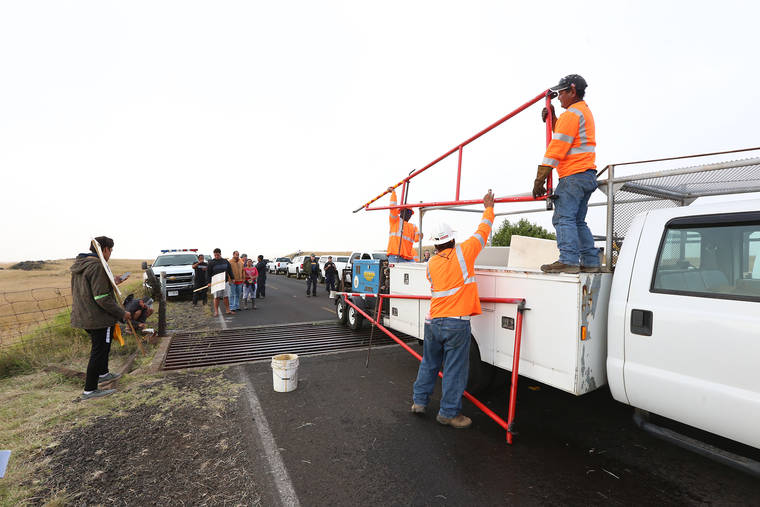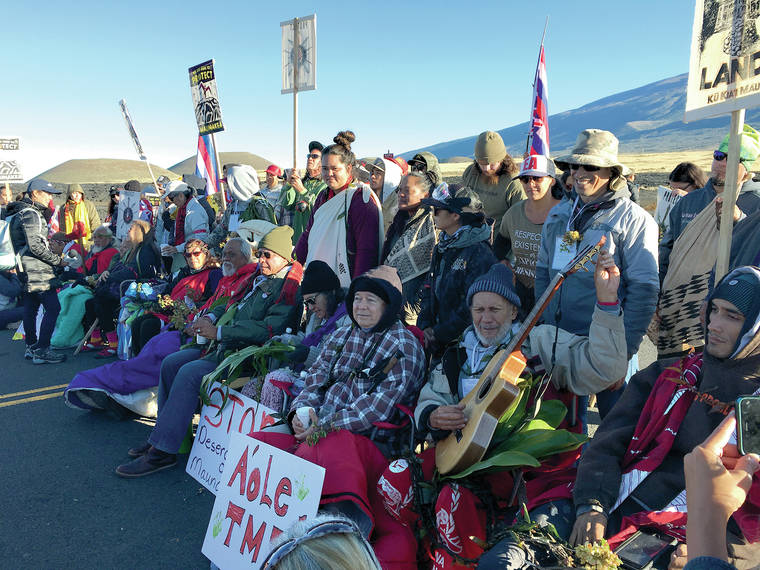MAUNAKEA — Following a daylong standoff between police and Thirty Meter Telescope protesters, both sides appeared to agree late Monday to a truce until daybreak today.
The agreement was made Monday evening after hundreds of protesters set up a human wall across the Maunakea Access Road about 100 feet from the Daniel K. Inouye Highway, preventing police from using the road.
The wall of protesters — who were locked arm-in-arm, singing and chanting — was formed after the state erected a gate over a cattle guard to which eight protesters chained themselves early Monday.
The eight voluntarily agreed to unchain themselves Monday afternoon after being told by police that neither they, nor any other protesters, would be arrested Monday. The gate was put up after many protesters dispersed from the area.
Protesters chanted “take down the gate,” and one called it a “breach of trust.” Some said the gate violated their right to have unfettered access up the mountain.
Before the gate was installed, Kahookahi Kanuha, a leader of the protesters — who refer to themselves as “kia‘i” or “protectors” of Maunakea, a mountain they consider sacred — described the decision to make no arrests as a victory for the protesters.
But earlier Monday, he and other protest leaders, such as Pua Case, repeatedly told protesters what to expect and how to behave if and when they were arrested.
Using a bullhorn, Kanuha told protesters, “These officers that we’re talking to, from what I can see, they’re not bad people. They’re not the enemy. The state is the enemy. … Until they escalate with us — not that we’re going to escalate, but the way we talk to them, be respectful.”
Kanuha likened Monday to a football game that’s not yet in the first quarter.
“Remember that we have a plan, and we trust in it. And it’s not an end all, be all, today,” he said.
One of the eight who chained themselves to the cattle guard in the road was longtime Hawaiian activist Walter Ritte Jr., who said early in the day that he and the others “are going to be here for a while.”
“We do not want those trucks up the mountain. We don’t want TMT on this mountain. This mountain represents more than just their building they want to build. This mountain represents the last thing they want to take that we will not give them,” Ritte said.
After freeing himself from the cattle guard, Ritte smiled at a Hawaii Police Department officer, shook the officer’s hand and said, “Maika‘i. Good job, you guys.”
Ritte said it was difficult lying there for 11 hours. He said protesters’ arms were connected through a series of metal pipes under the grate. Authorities would have had to cut the pipes to remove them, he said.
“It was so cold at 4 o’clock in the morning,” he said. “It was a test of our fortitude. This mountain is like our last stand.”
Before the eight protesters secured to the cattle guard were unchained, Case and Kanuha said a group of about 20 kupuna, or elders, were to be the first line to stand against law enforcement. Kanuha said the kupuna chose to sit in a line across the Maunakea Access Road, regardless of the consequences.
However, after those who were chained to the cattle guard were removed, the kupuna retreated to an encampment across the highway, called Pu‘uhonua o Pu‘u Huluhulu. When the protest was rekindled in earnest as the gate was erected, the kupuna returned to their vigil, surrounded by fellow protesters.
One protester, Kalani Lyman, said he was “prepared for the worst.”
“I came up here to be peaceful, but if I have to, I gotta do what I gotta do,” Lyman said.
While many protesters were clearly willing to risk personal injury or arrest to make their stand, others chose to remain out of harm’s way in order to provide support. Volunteers offered medical support and transported food, water and other supplies to those occupying the road.
“I have keiki, I can’t be on the front lines,” said protester Ala Savio. “So I’m here to help however I can, to fill whatever holes need filling.”
While most of the protesters are Native Hawaiians, there also were non-Hawaiians lending their support.
Ikuko Kurata said she is concerned about the extent to which TMT is funded by Japanese taxpayers, while activist Jim Albertini said he was arrested during the 2015 protests and was willing to be arrested again.
“It’s important for haoles to be a part of this, too,” Albertini said.
Throughout the day, hundreds of vehicles arrived, parking along the sides of the highway. Eventually, the abundance of vehicles prompted the state to set up concrete barriers along the sides of the road, cutting traffic down to a single lane for much of the day.
Jason Redulla, chief of the state Department of Land and Natural Resources’ Division of Conservation and Resources Enforcement, told the media that the priority of law enforcement was not to make arrests but to “create a safety buffer along Daniel K. Inouye Highway.” He added that no vehicles had been towed by Monday afternoon.
Redulla also said that, as of Monday afternoon, no arrests had been made, and only one person had required medical attention.
Rich Matsuda, chief of operations at W.M. Keck Observatory, said mid-afternoon that, as far as he was aware, there was “no current protester presence or activity” at the Maunakea Visitor Station or Halepohaku, which are at the 9,300-foot level of Maunakea.
“We had three telescopes with personnel on the summit (Sunday) night,” Matsuda said. “They were all able to get down from the summit safely to Halepohaku, but are not able to come down to (the highway) and leave the mountain.”
Matsuda said the personnel planned to go back to their respective telescopes Monday night if they could do so safely.
Maunakea in 2009 was selected as the site for the Thirty Meter Telescope, after a five-year, worldwide search for the ideal location.
Protests disrupted a groundbreaking and Hawaiian blessing ceremony at the TMT site in 2014. After that, the demonstrations intensified.
Construction stopped in April 2015 after dozens of protesters, including Kanuha, were arrested for blocking the work. A second attempt to restart construction a few months later ended with more arrests and crews pulling back.
On Oct. 30, 2018, the Hawaii Supreme Court ruled by a 4-1 vote to affirm the approval of the project’s Conservation District Use Permit by the state Board of Land and Natural Resources.
Gov. David Ige last month announced the DLNR issued a notice to proceed to the University of Hawaii at Hilo to allow construction of the telescope to begin.
The governor last week said the Maunakea Access Road would be closed starting Monday morning to allow construction trucks to proceed to the site on the mountain.
The consortium behind the TMT is comprised of a group of universities in California and Canada, with partners from China, India and Japan.


